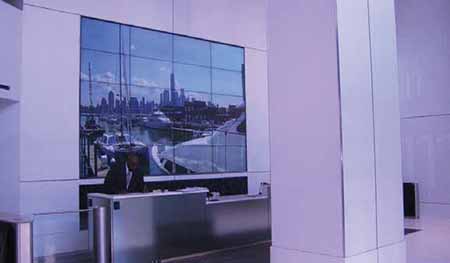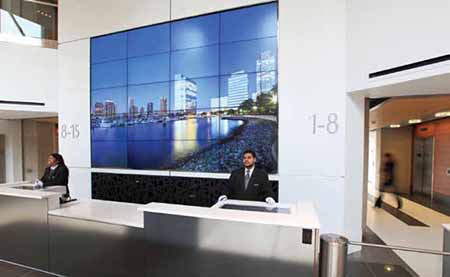LeFrak’s Videowall Looks Past Obstructions

LeFrak installed a PTZ HD camera outside to grab the best city views & feed to the videowall, which consists of 20 Samsung UD46C displays in a 5x4 configuration. The videowall sits behind the front desk where security staff can activate a still photo if needed.

A view of lower Manhattan is breathtaking…except when you can’t see it. The LeFrak Organization used an innovative videowall to enable that view at 111 Town Square Place.
LeFrak recently remodeled the lobby of the 15-story, Class-A building in Jersey City. The project included cutting back the lobby’s mezzanine balcony to open up the space and make room for a videowall. One thing that couldn’t be moved was the elevator banks, which blocked the lobby view of lower Manhattan, as well as the picturesque marina immediately adjacent to 111 Town Square Place.
The solution: add a pan-tilt-zoom (PTZ) HD camera outside to grab the marina and Manhattan view and then feed it to the videowall, which consists of 20 Samsung UD46C displays in a 5x4 configuration. The videowall sits immediately behind the front desk, where security staff can switch to a still photo when needed, such as when a yacht is blocking the view.
“In case of rain or snow, they can still display a sunny day view,” said Eli Hezi, essentialCom co-founder and partner, who was the project’s video consultant.
The videowall is designed to give LeFrak the ability to display other types of content in the future. For example, if LeFrak helped sponsor a community event such as a marathon, the videowall could display photos, video and other content about that event. The displays also can each show a separate image.
“It’s flexible enough to do anything we’d want,” said Elizabeth Muskat, LeFrak Property Management vice president for commercial construction and building management. “We could put any event content that would be appropriate on this wall.”
A daily selection of features, industry news, and analysis for tech managers. Sign up below.
The videowall already makes a great impression on existing and potential tenants.
“The transformation is quite remarkable,” Muskat said. “It gave the building the street appeal it deserves.”
Bring in the Pros
Pulling off the videowall wasn’t easy. The elevator banks that necessitated it left little room for cables and ventilation. Fans had to be shoehorned in to expel heat, with a screened cabinet void below to provide additional air flow. On the plus side, the lobby faces roughly north, so the videowall isn’t flooded with ambient light.
“We installed displays and mounts inside that allowed easy service: push for quick-release,” Hezi said.
The displays have 5.5 mm bezels, but the current generation is down to 3.5 mm. What happens if one or more displays have to be replaced, and 5.5 mm units no longer are available?
“The nice thing is you’re talking about only millimeters,” said Michael O’Halloran, Samsung product manager. “So across that wall, if there’s going to be an upgrade or retrofit, you’re looking at taking only about 10 to 15 mm up across the expanse of the wall with the entire footprint. That’s something folks shouldn’t be concerned about.”
Even so, it’s an understandable concern, one that highlights why it often makes sense for enterprises to hire AV pros for challenging projects. That’s what LeFrak did with Hezi and essentialCom.
“He gave us the parameters,” Muskat said. “We were able to have so much more after he defined our options. We really benefitted from his expertise, and we were really able to capitalize on his knowledge by bringing him in as early in the process as we did.”
Indeed, a key to successful AV projects often is making sure the integrator or consultant is brought into the project early. When AV pros can collaborate with architects, contractors, and others while a project is still in the planning phase, it typically saves money and headaches later.
“Eli was brought in at the very beginning, and we avoided the pitfalls of having to work things out in the field,” Muskat said. “We were able to avoid the typical issues that arise during construction because we had Eli on board during the construction documents phase.”
Tips & Solutions for Better Corporate Collaboration
#1 Don’t Choose an AV distribution platform that forces you to use either streaming or point-to-point distribution for the entire system.
For high-bandwidth, zero-latency presentation within a room, there’s no match for point-to-point connections such as HDBaseT. Point-to-point connections are required to transmit HDCP protected content. Most AV manufacturers force their customers onto a platform that supports only one or the other. For high-bandwidth, zero-latency connections within the room, use point-to-point connections such as HDBaseT. For distribution to mobile devices and to points around the world, use streaming. Crestron DigitalMedia accepts any type of signal or stream in, and then sends it out as any signal or stream type. For example, DM can accept a video stream over IP, and then distribute that signal via HDMI locally. Alternatively, local HDMI signals can be streamed out over IP.
#2 Specify products that are designed for enterprise environments.
While it’s necessary to make it easy to share content wirelessly from tablets and smartphones, it’s also important to maintain management and security. Enterprise bring your own (BYOD) solutions should leverage existing network infrastructure and security protocols. And they should support comprehensive management tools for centralized monitoring, updates, and control. Crestron AirMedia enables BYOD presentation without introducing unsecure wireless networks. The AirMedia desktop application can be centrally managed like the rest of the enterprise software. AirMedia itself can be centrally monitored, managed, and controlled—just like other network devices.
—Tom Barnett,director of marketing communications, Crestron
#3 Invest in secure wireless collaboration.
Kramer VIA provides another solution for secure wireless sharing and real-time collaboration. Any content sent from a participant’s device over the network to the VIA itself uses 1024 bit encryption. VIA also requires a secure room code to be entered by each participant at the beginning of each session to ensure that only team members in the room and in sight of the display device have access to the shared meeting space. This security code can be randomly generated at a user-definable interval from three to sixty minutes.
—Matt Kopin, product manager, Kramer Electronics
